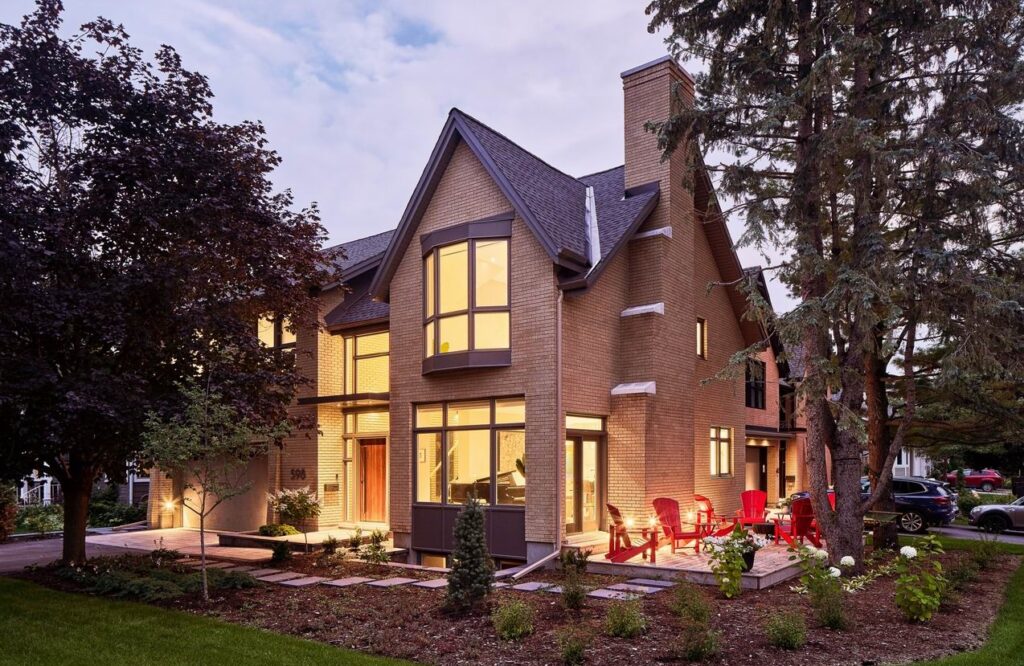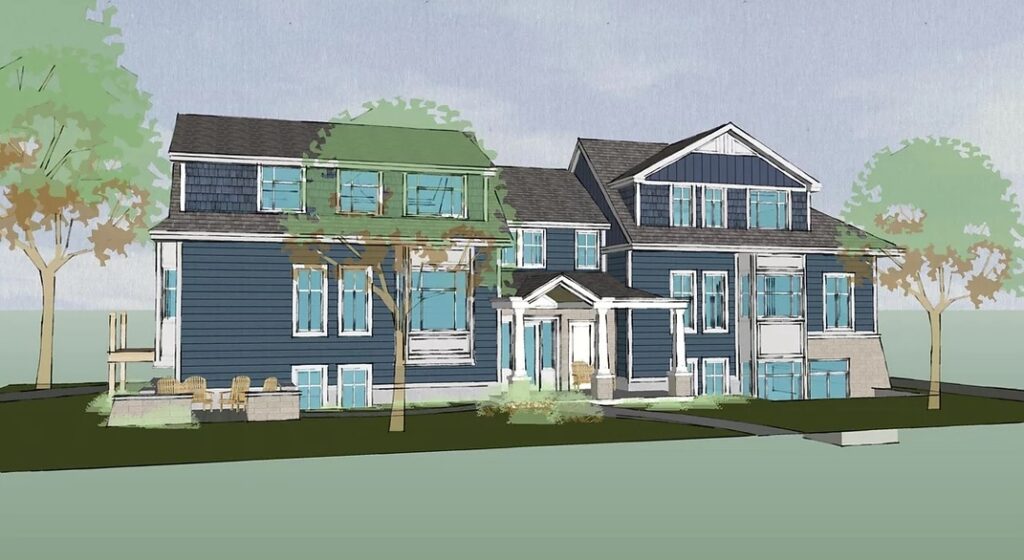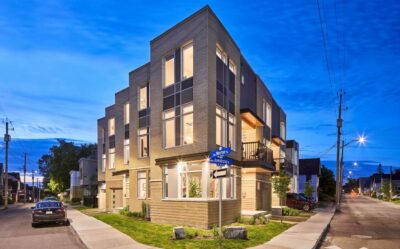Rosaline Hill is a study in contrasts. Architect, bush camping enthusiast, urban advocate, nature lover, entrepreneur, artist, approvals expert, and Ottawa’s designer of the year.
Yet these disparate aspects of her work, advocacy and character are all connected, really, so that the many pies she has her fingers in make sense.
When Hill was named the designer of the year at the Ottawa Housing Design Awards in November, that accomplishment and her three other award wins were enough to merit a closer look.
But she is much more than a multi-award-winning architect.
“She has a lot of irons in the fire,” says builder Rob Haslett of Haslett Construction, who shares office space with her and is a frequent collaborator on infill projects. “I don’t know where she finds the time or energy.”

Hill combines her professional expertise — and an aptitude for the intricacies of the city’s approvals process — with a driving passion for advocacy and creating a true sense of community.
“She naturally gravitates towards making community wherever she is,” says good friend Crystal Hache. “She’s genuinely caring and she really walks the talk, meaning community isn’t just an idea.”
Hill lives in a Britannia triplex (originally bought with Hache), where regular weekly dinners with neighbours have been common. And part of the appeal of being a member of her church — St. Alban’s Anglican in Sandy Hill — is its diverse congregation.
“I have friends there who live at the Mission… who are university students… different gender expressions, so a very interesting place to grow,” says the 49-year-old mother of two girls.
Hill’s community-making extends to her advocacy.

Not only is she an original member of the Urban Infill Council at the Greater Ottawa Home Builders’ Association (and the industry working group that preceded it), for the past three years she’s devoted countless hours to researching development patterns and the forces that generate change in neighbourhoods, primarily through intensification. That research has led to the building of a simulator to understand and map how intensification could happen in neighbourhoods under different regulatory scenarios. Hill expects the simulator to be ready for demonstrations soon and says the city has expressed interest in the project.
“I hope it will have a really big impact on the way that Ottawa chooses to grow,” she says. “The city is devoted to this general direction, but without modeling and simulation, it’s hard to get there, because you need to really understand the mechanics… to change the trajectory in a very significant way.”
In a sea of negativity surrounding the idea of intensifying (or densifying) our neighbourhoods, Hill is a refreshingly positive proponent — and one with specific ideas on how it should be achieved.
“People are angry because they see infill in their neighbourhood that doesn’t have any logic or purpose behind it… and nobody seems to be driving the ship and it’s frustrating,” she says.

Good infill, and by extension intensification, is not simply replacing a single home with an even larger single home, or a block of homes with a bulky apartment building. It’s about “inside the box” thinking that creates smart multi-unit dwellings that are currently not allowed in the zoning, she says.
“My research into development patterns in neighbourhoods is important because I can demonstrate that we can meet very significant intensification targets without increasing the height.”
It’s also about moving toward neighbourhoods that are walkable, offering all the amenities a resident would need within walking distance and reducing car dependency — also referred to as 15-minute neighbourhoods.
Frustrated by what she saw as lots of talk about the value of walkable neighbourhoods yet little action to figure out how we get there, she started Walkable Ottawa in 2020. The grassroots group is working toward moving that agenda forward, including holding workshops in various neighbourhoods and offering constructive comments during the city’s Official Plan process.
“Walkable Ottawa and the infill modeling are all in an effort to see our neighbourhoods grow in more healthy ways and to get people on board with the idea that our cities can evolve differently,” she says.
MORE: Rosaline Hill talks infill and intensification
Hill’s sense of community has also extended to a new initiative launched this month, called Ottawa Cohousing.
The basic concept is a grouping of homes, often a condo, in which those who choose to live there have done so because they want more community engagement.
“It could be exactly the same as the condominium next door physically, but there’s an intention to be participating,” Hill says.
Started with business partner Linda Kruus, Ottawa Cohousing will bring together groups of like-minded individuals or families and match them to an appropriate developer or builder, then help them through the whole process of realizing their cohousing goal. Hill and Kruus hope to have their first group matched to a site by the end of the year.

It’s a housing arrangement Hill could see herself in at some point, and even did try to organize about 20 years ago. However, at the time she hadn’t yet honed her development expertise and the attempt failed.
“Now I’m in a completely different place; I know how development works,” she says. “So, for me to be able to get a group set up with an appropriate developer and matching the right piece of property, it’s not the challenge (for me) that it is for a cohouse group. I’m well-positioned to make that happen.”
A Toronto native, Hill did her schooling at the University of Waterloo and eventually made her way to Ottawa, where she joined the team at Hobin Architecture. That gave her the ability to work on many types of architecture and find her niche in urban infill and development approvals.
“He’s fantastic with approvals,” she says of the firm’s founder, Barry Hobin, “so I was learning from the best.”



For his part, Hobin describes her as a problem solver and communicator, as opposed to a style-driven designer. Although it’s been a decade since she has worked for him (she set up her own firm, Rosaline J. Hill Architect, in 2011), he says she is “an individual of great integrity, with insightful understanding of how design can shape a better neighbourhood and the city as a whole.”
Adds planner Murray Chown of Novatech, who shares her interest in infill and intensification and has worked with her in advocating for smart infill: “She certainly is very concerned about the urban neighbourhoods, how they’re going to evolve and mature over time. (She) has a vision that she believes is achievable and will be of tremendous benefit.”
Her vision for the evolution of Ottawa is towards walkable neighbourhoods, she says.
“It’s the single most significant thing that we can do to reduce our emissions… It’s also a key to tackling our housing affordability problem, because lifestyles are so much more affordable in a walkable neighbourhood… A car-dependent lifestyle is fundamentally more expensive.”
But she doesn’t see herself as an urban champion — “That would be extremely arrogant,” she says — although she does allow that she’s an urban advocate.
“I believe it’s important to speak up and make waves when it matters… If I’ve been given the tools and the abilities and the opportunity to make a difference, then I have a responsibility.”



